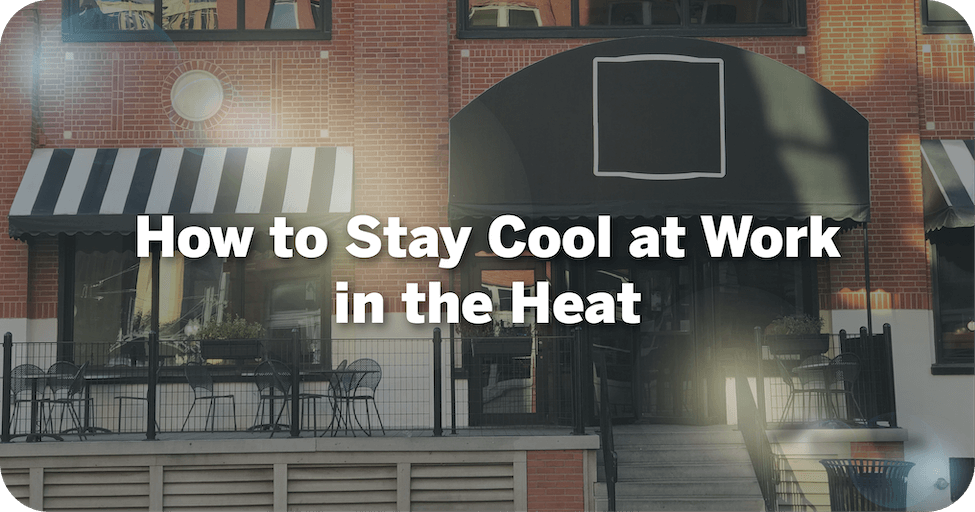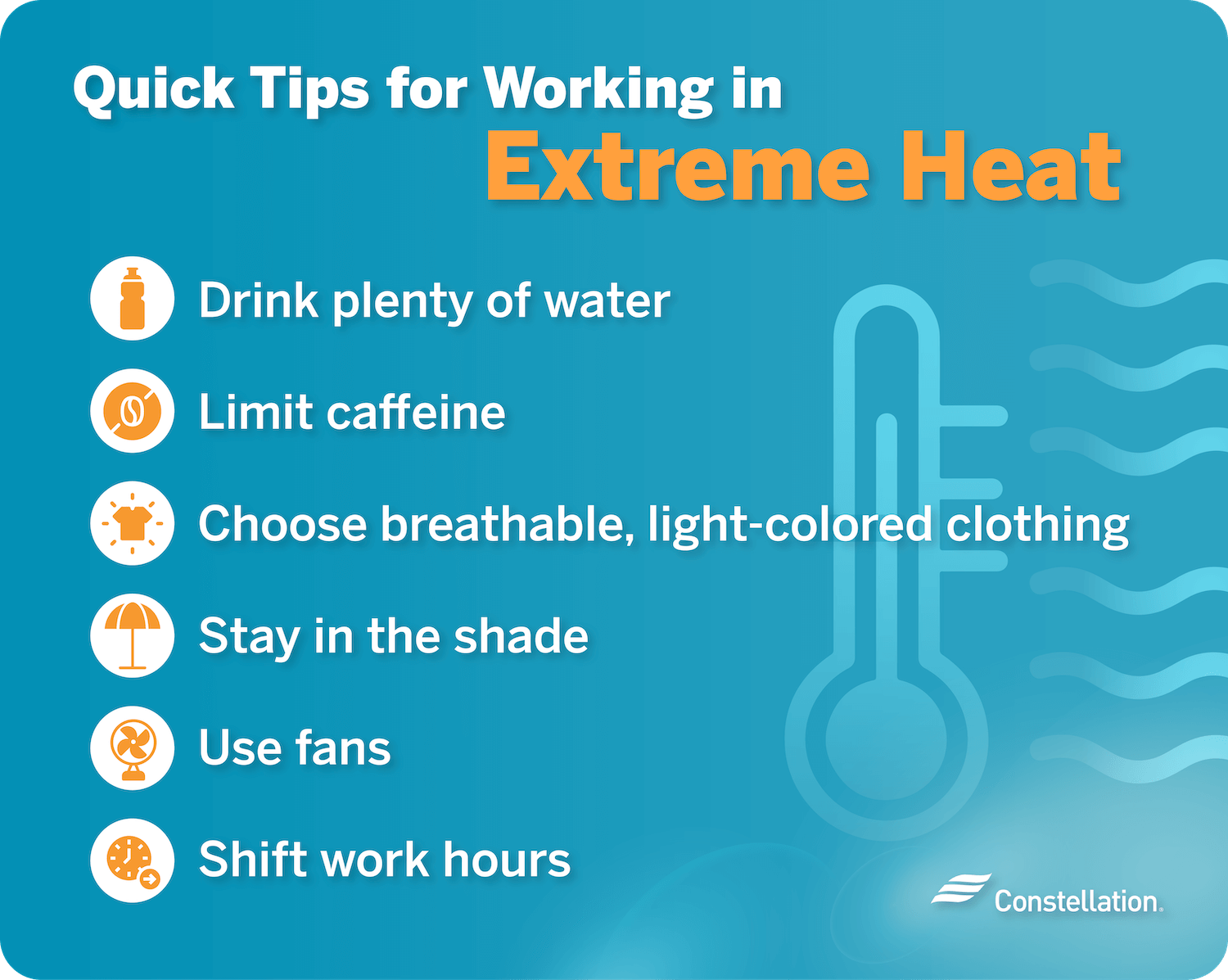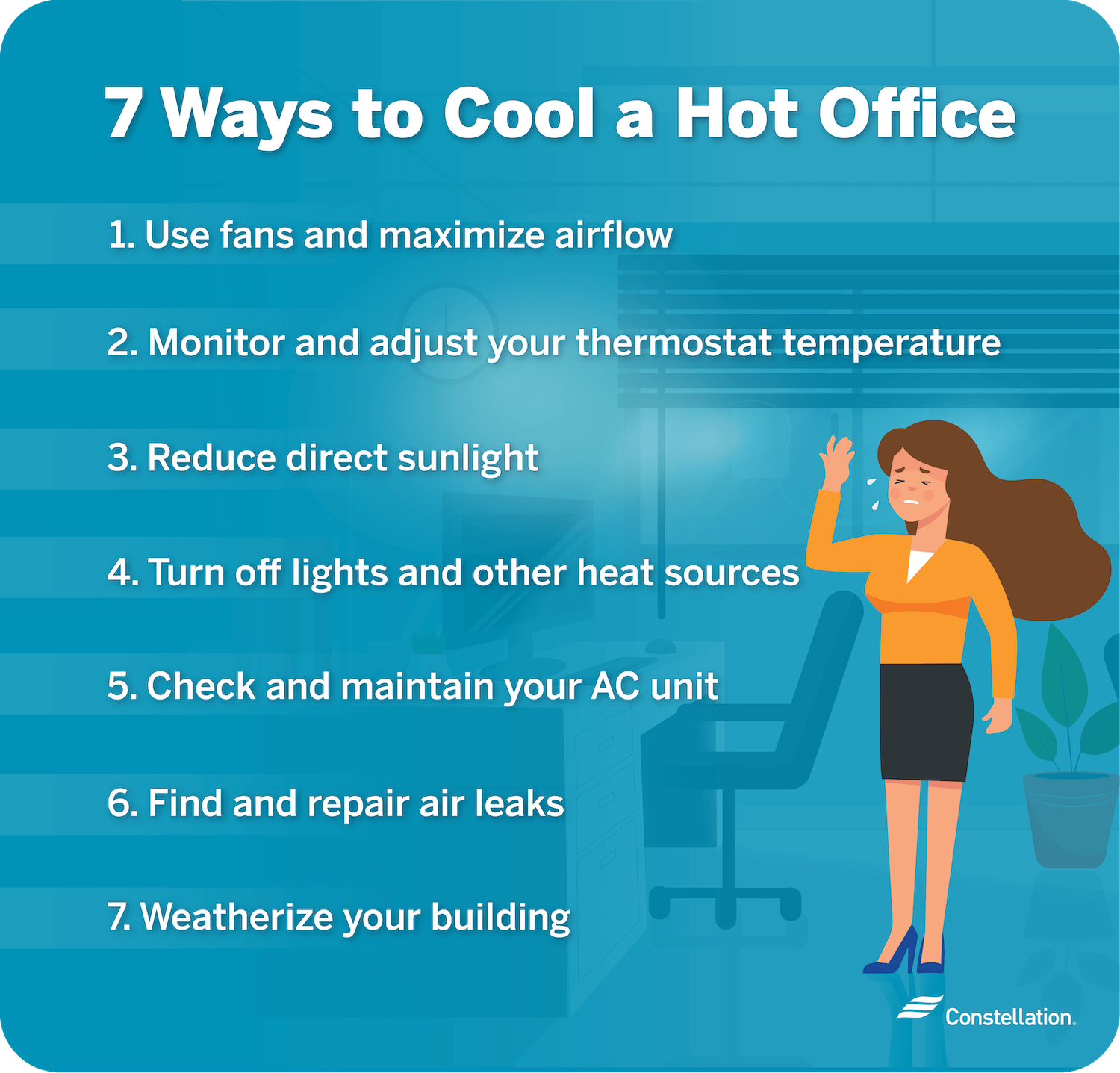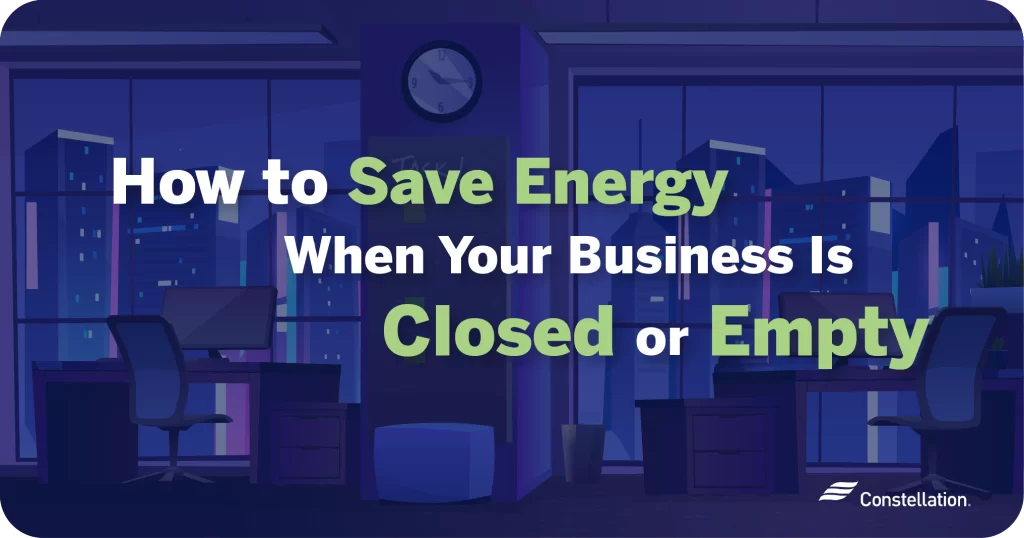
- Category:
Small Business Energy Savings -
Last updated:
August 13, 2025
How to Stay Cool at Work in the Heat
High summer temperatures mean more than high energy costs for your business — if your workplace is too hot, it can drag productivity and morale down. It can also harm worker health. Finding ways to stay cool without burdening your HVAC, workers and budget is essential during the hot summer months.
Making a few smart moves can lower your energy usage while keeping your workers comfortable and contributing to a more sustainable, efficient business. Below are some practical and budget-friendly tips to beat the summer heat.
Quick tips for working in extreme heat
Soaring temperatures put a major burden on your business. Here are some simple, yet effective ideas that help everyone stay cool and comfortable while giving your energy bill a break:
- Drink plenty of water. Hydration helps regulate body temperature and reduces the risk of heat-related issues, like fatigue.
- Limit caffeine. Colas, coffee and energy drinks can dehydrate you. Even over ice, caffeinated beverages make it harder to stay cool.
- Choose breathable, light-colored clothing. Cotton and linen allow air and moisture to pass through more easily, speeding evaporation for a cooling effect.
- Stay in the shade. If workers are outside, call for regular breaks in the shade with cool beverages.
- Use fans. Fans circulate cool air, and moving air helps with evaporation for a cool feeling on the skin.
- Shift work hours. If possible, start earlier in the day and consider a longer midday break when the temperatures are at their highest.

How can you help your employees stay cool?
Keeping your employees comfortable in times of extreme heat is as much about health and safety as it is about productivity and morale. Adjusting work schedules to avoid peak heat and scheduling more breaks, especially for outdoor workers, can prevent heat exhaustion and burnout.
A cooler workplace may also involve relaxing your dress code, providing personal cooling devices or fans and making ice and cold water freely available. These can enhance employee well-being, reduce absenteeism and boost morale.
Optimizing your operating hours in the summer may help you trim your power bill without negatively affecting customer service. In some societies, closing in the early afternoon — often the hottest time of day — is common practice. Offering summer Fridays off work can also save you money.
7 ways to cool down a hot office space
It takes a smart mix of tactics to keep your small business cool in the summer. Adjusting your workspace and working hours, combined with heat-fighting habits, can get you through heat waves. Consider the following tips and decide which of them are the best ways to cool your hot office space:
1. Use fans and maximize airflow
Good airflow and ventilation work wonders when trying to keep cool and control energy use.
Ceiling fans circulate cool air and give your air conditioner a break. The correct ceiling fan direction for summer is counterclockwise. That pushes cooling air down in a column, creating a breeze that also enhances the cooling effect. Ceiling fans don’t cool the air, but the cool feeling they create allows you to set your thermostat a few degrees warmer, saving a bit of energy.
Other tips for maximizing air flow include:
- Using box and oscillating fans: Putting these in or near open windows can pull in cool air in the evening and early morning.
- Installing ventilation fans: Push out hot air that collects near the ceiling or in attics. A ventilation fan removes hot air and pulls up cooler air.
- Promoting cross-breezes: Opening windows and doors on opposite sides of a room helps to move air through it.
- Opening your interiors: Open doors inside your space to promote air circulation.
2. Monitor and adjust your thermostat temperature
When it comes to your thermostat in the summer, don’t set it and forget it. Keep your space cool only when people are working. You don’t need to crank the A/C in the evening and on weekends.
OSHA suggests a temperature between 68–76 degrees with humidity in the 20–60% range. Set the thermostat to 78 degrees when people are working and then put it at 85 degrees after hours. You’ll add up to 3% savings for each degree you raise your thermostat in the summer.
3. Reduce direct sunlight
Sunlight beating down into your workplace through windows can raise the inside temperatures quickly. Angling your shades will dramatically cool a room. Pulling curtains across windows when the sun is shining into them reflects the heat energy out of the room and adds a layer of insulation.
Here are additional ways to block heat:
- Add reflective film. You can block more solar heat and protect your furnishings from UV light with inexpensive stick-on window films.
- Use insulated curtains. Blocking radiant heat coming in your windows helps control interior temperatures. They work in winter to keep cold drafts out, too.
- Add outside shade. Plantings that shade your windows help cool things down. Awnings and overhangs are traditional ways to further control the heat coming in.
- Close windows and blinds. Shut windows and pull the shades when the sun is directly hitting a window. Southern- and western-facing windows typically get the most sun.
4. Turn off lights and other heat sources
Old-fashioned incandescent light bulbs can really cook a room. Up to 90% of the energy they consume goes to throwing off heat, not light. Turn off lights in rooms when not in use and switch to energy-efficient light bulbs, like LED or CFL bulbs.
Everything from copiers to toaster ovens contribute to heating the interior of your business. Try to keep their use to a minimum. Switching to solid-state computer processors eliminates a considerable amount of heat, too.
5. Check and maintain your AC unit
A clean AC unit will run more efficiently. Change the air filters and check to see if leaves and other debris have collected on or around the condensing unit. Check all vents to make sure they’re open and clean.
Even energy-efficient air conditioners can benefit from a professional inspection. A little preventative maintenance ensures you get the most from your unit all summer long.
6. Find and repair air leaks
Another tip for how to keep employees cool in the summer is to find and repair air leaks. Places that are drafty can leak cool air and let in hot air. Check for gaps in areas that commonly have leaks: around doors, windows and entry points for utilities. You can sometimes feel the drafts with your bare hand, or you can use a candle to see if it flickers.
7. Weatherize your building
Weatherizing your building for summer can help keep the inside cooler. If your windows are old, the savings in both summer and winter can quickly pay for their cost of replacement. Installing a cool roof that reflects the sun’s rays also can pay for itself in no time.
But you don’t have to spend a lot of money to keep your office cool in summer. Less-expensive tactics, like weatherstripping around doors and windows and planting shade trees around windows, can also be effective.
How does extreme heat impact small businesses?
High temperatures are a strain on your business. Extreme heat can lead to health issues like heat stress and fatigue. The result can be higher absenteeism and healthcare costs.
Scorching days can also affect productivity. Studies track a 30–35% drop in output when workers report overheating.
Foot traffic and economic activity also drop when temperatures soar, with some studies suggesting an annual cost of $100 billion in lost economic productivity over a season of hot days.
Finding ways to stay cool through peak summer heat can help you be more efficient and maintain productivity for a better bottom line.
Staying productive when the temperature is high
Heat waves and scorching summer days affect employee well-being, customer traffic and your energy costs. Staying cool is about more than just being comfortable; it’s necessary for your business.
Electricity costs spike during the heat of summer. Because electricity is such a big cost for many businesses, it makes sense to cut your small business’ summer expenses as much as possible. Create a checklist of ways to cut small-business energy costs, such as promoting air flow, blocking heat and adjusting hours, to keep employees cool and help control energy usage.
There’s no single best way to cool down, but combining tactics really works. Each small change, from adding fans and closing blinds to adjusting your dress code, improves comfort and saves energy. With thoughtful planning and preparation, you can cut energy consumption without sacrificing comfort or productivity.





